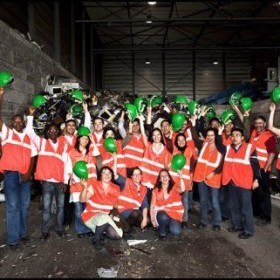StEP released a new Green Paper on Leaded Glass from CRTs

The United Nations’ Solving the E-waste Problem (StEP) Initiative, founded in 2007, is a global consortium of companies, research institutes, governmental agencies, international organisations and NGOs dedicated to advancing the management and development of environmentally, economically and ethically sound e-waste resource recovery, reuse and prevention. The StEP Initiative does not endorse any specific products and seeks instead to provide science-based but applied recommendations towards a sustainable solution to the e-waste issue.
As one of its members, WorldLoop is pleased to be able to contribute, collaborate and learn from this unique organisation of diverse stakeholders sharing the common goal to address the e-waste problem.
One of the latest StEP Green research papers, published a month ago, is dedicated to the discussion of consequences of the cathode ray tube screens’ (CRTs) replacement by flat screens, which resulted in a significant amount of end-of-life CRTs stranded. The main focus of the review is the fate of lead in the new products and repositories. CRTs, which contain 1 to 1.5 kg of lead per screen, can be mainly found in the funnel and neck glass for radiation protection purposes. The lead content makes this CRT glass unsuitable in most glass applications. Therefore, StEP emphasizes the need for alternative recycling options that are able to use up the CRT leaded glass while safely retaining the lead out of contact with humans and the environment.
The main findings from the paper are the following:
- The recycling or disposal of the CRT leaded glass is of particular concern as the high lead oxide (PbO) content makes the glass unsuitable for most current glass applications;
- Considering the quantities of lead in CRTs and the decreasing lead exposure limits, an updated review of the recycling possibilities for CRT leaded glass is used in other products, with a particular focus on the fate of lead during use, is necessary.
After a thorough analysis of the potential options of managing CRTs, StEP has suggested following options:
- RECYCLING: The main material to be replaced by CRT leaded glass in most of the products proposed in the literature reviewed was silica or sand. For instance, tableware crystal glass might benefit from both the silica and the PbO in CRT leaded glass, considering that crystal glass contains 55 to 65% silica and 7 to 32% PbO. However, it is important to mention that the Joint Food and Agriculture/World Health Organization Expert Committee on Food Additives (JECFA) concluded that it was not possible to establish a new Provisional Tolerable Weekly Intake (PTWI) for lead that would be considered health protective.
- DISPOSAL: The current legislation in Europe categorizes CRT leaded glass under waste containing heavy metals and mandates to dispose it of in landfills for stabilized residues. CRT leaded glass may be used for backfilling old mines; provided that the materials are later reclaimed. However, STEP researchers mention that they were not able to find information regarding this practice. Although disposal represents an environmentally sound option for CRT leaded glass treatment, in cases in which the glass in mixed with other hazardous wastes, these options diminish the future availability of lead.
The paper concludes that in order to assure a stable throughput of CRT leaded glass for the specific products, a country or regional based assessment of the current stock and expected end-of-life flows of CRT screens is necessary.
Click here to download the full Green Paper
“Step’s aim is to reduce dangers to humans and the environment which result from inadequate and irresponsible treatment practices. Crucially, Step aims to advance resource efficiency and prevent ongoing e-waste generation”
Dr. Ruediger Kuehr
Executive Secretary & Co-Founder, Step Initiative & United Nations University

